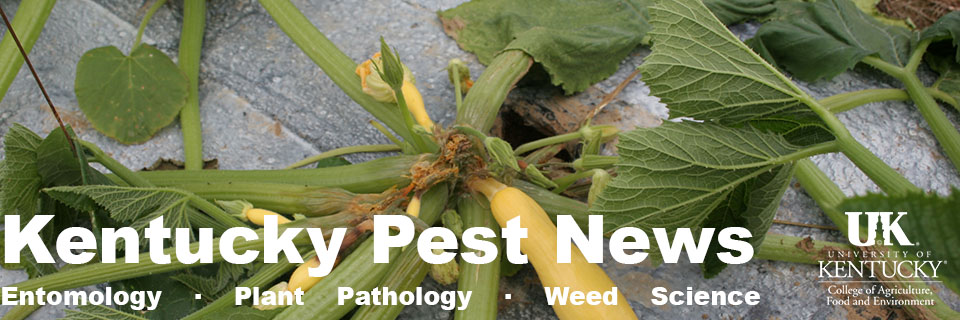Fall armyworm (FAW) is a migratory pest that re-infests Kentucky each summer and is killed by frost in the fall. It often shows up later in the season after corn has tassled and lost its attractiveness to this pest. But…
Monthly Archives: July 2021
Watch Pastures for True Armyworm
There has been one report of true armyworm in pastures, and moth numbers increased dramatically the week before last in Lexington. While I also have a KPN article on fall armyworm in western Kentucky this week, keep in mind these…
Cucurbit Mesotunnel Research Blog
We have been researching improved conventional and organic control strategies for cucurbit pests and diseases for more than 10 years to develop a practical system that producers can use effectively and dependably. This work have been conducted at the UK…
How Dry Season Affect Woody Plants
Water is an essential component to plant mass and is vital to growth, carbohydrate production, and nutrient transport. During periods of below-average rainfall or when rain distribution is uneven, plant health may decline (Figure 1). Drought conditions or inadequate water…
Spotted Lanternfly on our Border
Last week, some distressing news was delivered regarding spotted lanternfly, a worrisome invasive species. Unfortunately, an infestation of this pest was found in Southeastern Indiana, specifically near the city of Vevay in Switzerland County. The location is about 2.4 miles…
Stinging Ants in Kentucky
Ants bite! And several in Kentucky can also deliver a painful sting. Just like their close bee and wasp relatives, it is only the female ants that are equipped with stingers for defense. Fortunately with ants, only a few species…
The Basics of Biofumigation (CCD-FS-20)
With their typically broad host ranges, soilborne pathogens and plant-parasitic nematodes can be especially difficult to manage once they become established in soils. Biofumigants can be an option for disrupting disease and nematode life cycles and are especially beneficial when…
2021 Insect Trap Counts
Trap counts for major insect pests are provided by the Kentucky IPM Program. Traps are located at the UK Research and Education Center in western Kentucky and the UK Spindletop Farm in Lexington. Below are trap counts for the current…
Spider Mites Damage Observed in Soybeans in Western Kentucky
The two-spotted spider mite (Tetranychus urticae) is probably one the most polyphagous pests in the world. Two-spotted spider mites feed on leaves, stems, and fruit of many plant species by piercing cells and sucking out cell contents. This injury causes…
Stress and Decline in Woody Plants
Woody trees and shrubs may exhibit decline resulting from the stresses that can occur during their lives. Stress may be the result of improper plant or site selection, incorrect planting or maintenance practices, or poor soil conditions. Injury from equipment,…
Non-Monarch Milkweed Munchers
Monarch butterflies are one of the few insects we could describe as “beloved” by much of the public. Due to their popularity, we have seen an increase in folks wanting to create their own monarch plantings made up of milkweed…
Flies and Pink Eye a Problem Again This Summer
Face flies are annoying pests for cattle that can impact the animal’s welfare by just constantly molesting the eyes of our animals. These flies are looking to feed on tears but will also feed on saliva, blood, and nasal discharges.…
Common Problems of Common Trees (PPFS-OR-W-30) & Common Problems of Common Shrubs (PPFS-OR-W-31)
Trees and shrubs are important aspects of landscapes and woodlands. However, these woody ornamentals may experience a wide range of issues, including diseases, insects, and abiotic disorders. The most frequently observed problems of trees and shrubs commonly growing in Kentucky…
2021 Insect Trap Counts
Trap counts for major insect pests are provided by the Kentucky IPM Program. Traps are located at the UK Research and Education Center in western Kentucky and the UK Spindletop Farm in Lexington. Below are trap counts for the current…
Dicamba Off-target Movement Continues in 2021
There have been several reports of dicamba off-target movement onto soybean and other sensitive crops reported over the last two weeks in parts of Kentucky. Despite four years of applicator training and three label changes to enhance restrictions and nullify…
